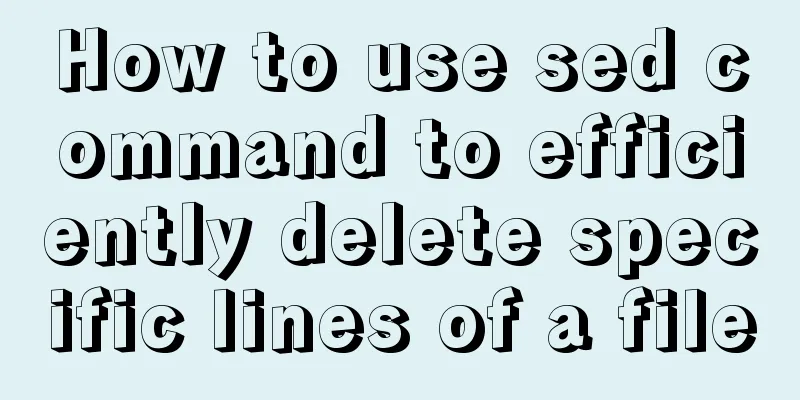How to use sed command to efficiently delete specific lines of a file

|
Preface Normally, if we want to delete certain lines in a file, we usually open the file first, then find the content to be deleted, then select these lines and press the delete key to delete them. This is not a problem when the amount of data is small. However, once there are a lot of rows of data in the file and the data is complicated, it will be terrible if you still use the above method. To this end, today's article will show you how to use the sed command line tool to efficiently and elegantly delete specific lines of content in a file even when the data is large and complex. sed is the abbreviation of Stream Editor. It is used for basic text conversion in Linux. It is an important command for file operations. Therefore, we can also use it to delete text. The following are some examples of using the sed command, covering most usage scenarios. They help you learn the sed command from the simplest to the most complex, allowing you to easily and efficiently delete specific lines of a file. First we prepare a demonstration file sed-demo.txt. # cat sed-demo.txt 1 Linux Operating System 2 Unix Operating System 3 RHEL 4 Red Hat 5 Fedora 6 Arch Linux 7 CentOS 8 Debian 9. Ubuntu 10 openSUSE Then we can experiment with the sed command. Note: -i means to perform file operations directly without displaying the results on the terminal. Because this is a demonstration, the -i option is not used here. In practice, please use the -i option. 1. Delete a row First, we start by deleting a row, such as the first row or the last row, which is actually the Nth row. The command format to delete line N is: sed 'Nd' file Let's try deleting the first line: # sed '1d' sed-demo.txt After deletion: 2 Unix Operating System 3 RHEL 4 Red Hat 5 Fedora 6 Arch Linux 7 CentOS 8 Debian 9. Ubuntu 10 openSUSE Simple, right? I won't explain it in detail here. Just replace 1 in the command with the line you want to delete. Now the question is, what number is used to represent the last line? Here is a tip for everyone. You can use the dollar sign $ to represent the end, so the command to delete the last line can be written like this: # sed '$d' sed-demo.txt After deletion: 1 Linux Operating System 2 Unix Operating System 3 RHEL 4 Red Hat 5 Fedora 6 Arch Linux 7 CentOS 8 Debian 9. Ubuntu 2. Delete some rows The sed command can delete consecutive or non-consecutive lines. Delete consecutive lines, for example, delete lines 5 to 7: # sed '5,7d' sed-demo.txt After deletion: 1 Linux Operating System 2 Unix Operating System 3 RHEL 4 Red Hat 8 Debian 9. Ubuntu 10 openSUSE Delete non-consecutive rows, for example, delete the 1st, 5th, 9th, and last row: # sed '1d;5d;9d;$d' sed-demo.txt After deletion: 2 Unix Operating System 3 RHEL 4 Red Hat 6 Arch Linux 7 CentOS 8 Debian In addition, it can also be used with logical NOT!, for example, to delete all rows except rows 3 to 6: # sed '3,6!d' sed-demo.txt After deletion: 3 RHEL 4 Red Hat 5 Fedora 6 Arch Linux 3. Delete blank lines sed also supports deleting blank lines of files. The command is as follows: # sed '/^$/d' sed-demo.txt After deletion: 1 Linux Operating System 2 Unix Operating System 3 RHEL 4 Red Hat 5 Fedora 6 Arch Linux 7 CentOS 8 Debian 9. Ubuntu 10 openSUSE Tip: The expression between the two slashes // here plays the role of text matching. You can refer to the usage of regular expressions. Below are some commonly used methods to deepen your learning. 4. Delete lines containing specific characters Suppose we want to delete the lines containing the word System in the sample file. We can use /System/, which means to match the string System whenever it appears. The specific command is as follows: # sed '/System/d' sed-demo.txt After deletion: 3 RHEL 4 Red Hat 5 Fedora 6 Arch Linux 7 CentOS 8 Debian 9. Ubuntu 10 openSUSE Not only that, we can also add logical conditions, such as the following command: # sed '/System\|Linux/d' sed-demo.txt After deletion: 3 RHEL 4 Red Hat 5 Fedora 7 CentOS 8 Debian 9. Ubuntu 10 openSUSE The symbol \| represents logical OR. The above command means that all lines containing System or Linux in the text should be deleted. 5. Delete lines starting with specific characters First, we create another sample file sed-demo-1.txt for better demonstration, its content is as follows: # cat sed-demo-1.txt After deletion: Linux Operating System Unix Operating System RHEL Red Hat Fedora debian ubuntu Arch Linux - 1 2 – Manjaro 3 4 5 6 As mentioned above, the $ sign can be understood as the end, so is there any character that can represent the beginning? The answer is yes. Here we can use the ^ sign to represent the beginning. Then, if we want to delete the lines that start with a certain character, for example, to delete the lines that start with R, we can use the following command: # sed '/^R/d' sed-demo-1.txt After deletion: Linux Operating System Unix Operating System Fedora debian ubuntu Arch Linux - 1 2 – Manjaro 3 4 5 6 So the question is, for example, if I want to delete the line starting with R or F, do I have to execute the command twice? If there are more, don't you have to execute multiple commands? Here is a simple way to write it. You just need to write these characters in a pair of square brackets []: # sed '/^[RF]/d' sed-demo-1.txt After deletion: Linux Operating System Unix Operating System debian ubuntu Arch Linux - 1 2 – Manjaro 3 4 5 6 The above command is used to delete the lines starting with R or F. 6. Delete lines ending with specific characters The same principle applies to deleting lines ending with a certain character. For example, to delete lines ending with m, we can do this: # sed '/m$/d' sed-demo.txt After deletion: 3 RHEL 4 Red Hat 5 Fedora 6 Arch Linux 7 CentOS 8 Debian 9. Ubuntu 10 openSUSE To delete lines ending with x or m, you can write: # sed '/[xm]$/d' sed-demo.txt After deletion: 3 RHEL 4 Red Hat 5 Fedora 7 CentOS 8 Debian 9. Ubuntu 10 openSUSE 7. Delete lines starting with a capital letter Here comes the question again, what if I want to delete all the lines that start with a capital letter? According to the above method, do we need to write all 26 letters from A to Z into [ ]? In fact, we don't have to do this, we can just add a - between A and Z: # sed '/^[A-Z]/d' sed-demo-1.txt After deletion: debian ubuntu 2 – Manjaro 3 4 5 6 You are smart enough to think of other similar usages after reading this. Why not take a look at the following commands to see if there are any you think of. 8. Delete lines containing alphabetic characters # sed '/[A-Za-z]/d' sed-demo-1.txt After deletion: 3 4 5 6 9. Delete the lines containing numbers # sed '/[0-9]/d' sed-demo-1.txt After deletion: Linux Operating System Unix Operating System RHEL Red Hat Fedora debian ubuntu Additionally, through this example, we can add ^ and $ to better see the difference between the three: # sed '/^[0-9]/d' sed-demo-1.txt After deletion: Linux Operating System Unix Operating System RHEL Red Hat Fedora debian ubuntu Arch Linux - 1 # sed '/[0-9]$/d' sed-demo-1.txt After deletion: Linux Operating System Unix Operating System RHEL Red Hat Fedora debian ubuntu 2 – Manjaro 10. More In fact, the file content we want to delete is more specific, and simple conditions cannot meet our needs, so sed also supports more complex condition combinations. For example, if I want to delete the words Linux in lines 1 to 6, then:
# sed '1,6{/Linux/d;}' sed-demo.txt
After deletion:
2 Unix Operating System
3 RHEL
4 Red Hat
5 Fedora
7 CentOS
8 Debian
9. Ubuntu
10 openSUSE
Delete the line containing System and the following line:
# sed '/System/{N;d;}' sed-demo.txt
After deletion:
3 RHEL
4 Red Hat
5 Fedora
6 Arch Linux
7 CentOS
8 Debian
9. Ubuntu
10 openSUSE
Summarize This concludes this article on how to use the sed command to efficiently delete specific lines of a file. For more information about how to use the sed command to delete specific lines of a file, please search 123WORDPRESS.COM’s previous articles or continue browsing the following related articles. I hope you will support 123WORDPRESS.COM in the future! You may also be interested in:
|
<<: Example code of Vue3 encapsulated magnifying glass component
>>: Analyzing the MySql CURRENT_TIMESTAMP function by example
Recommend
English: A link tag will automatically complete href in IE
English: A link tag will automatically complete h...
Summary of the application of decorative elements in web design
<br />Preface: Before reading this tutorial,...
Let's talk about the storage engine in MySQL
Basics In a relational database, each data table ...
Awk command line or script that helps you sort text files (recommended)
Awk is a powerful tool that can perform some task...
Detailed explanation of Nginx log customization and enabling log buffer
Preface If you want to count the source of websit...
Detailed explanation of node.js installation and HbuilderX configuration
npm installation tutorial: 1. Download the Node.j...
MySQL method steps to determine whether it is a subset
Table of contents 1. Problem 2. Solution Option 1...
Summary of Vue component basics
Component Basics 1 Component Reuse Components are...
A brief understanding of the three principles of adding MySQL indexes
1. The Importance of Indexes Indexes are used to ...
Solution to the problem that Centos8 cannot install docker
Problem [root@zh ~]# [root@zh ~]# [root@zh ~]# yu...
Detailed explanation of the use of Vue image drag and drop zoom component
The specific usage of the Vue image drag and drop...
Usage instructions for the docker create command
The docker create command can create a container ...
Detailed explanation of how MySQL solves phantom reads
1. What is phantom reading? In a transaction, aft...
How to delete table data in MySQL
There are two ways to delete data in MySQL, one i...
Implementation of pushing Docker images to Docker Hub
After the image is built successfully, it can be ...









